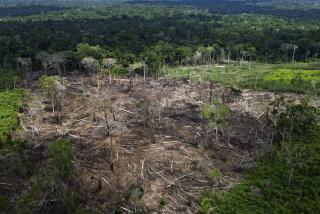We finally know how many trees there are in the world
- Share via
How many trees are there on planet Earth?
According to a new study, the answer is somewhere around 3.04 trillion.
That’s about 400 trees for every person.
And while that may seem like a lot, scientists say that before humans began clearing forests, the Earth was home to nearly twice as many trees.
“The number of trees cut down is almost 3 trillion since the start of human civilization,” said Thomas Crowther a postdoctoral fellow at the Yale School of Forestry & Environmental Studies and lead author of the study published this week in Nature. “That is an astronomical figure.”
Previous estimates of the Earth’s tree population put the number at 400.25 billion. That’s nearly an order of magnitude less than the new tally.
(And just so we are all on the same page, the authors define “tree” as a plant with a woody stem that is at least 10 centimeters wide at breast height.)
Scientists say the discrepancy has to do with how the two estimates were calculated. Earlier studies used satellite data to determine how many trees were living on Earth. But that was tricky because while satellites can accurately detect which areas of the planet are forested, in most cases they cannot see individual trees.
“Satellite images can tell you a lot about the forest area and canopy cover,” Crowther said. “What we provide is a more detailed understanding of what is going on beneath the surface.”
Trees serve several crucial functions for the planet. Among other things, they create habitat for animals and plants and cycle water and nutrients through ecosystems. One of the most important roles that trees currently play is taking carbon dioxide out of the air and transferring it to living things.
“Almost half of what comes out of our car tail pipes and factories gets absorbed by nature and from this half, one-fourth of it goes to trees,” said Sassan Saatchi, who studies the planet’s carbon cycle at NASA’s Jet Propulsion Laboratory in La Cañada Flintridge.
The new study incorporates satellite imagery, but it also relies on 429,775 ground-based measurements of tree density made by an actual person who counted the number of trees in a given area.
“That is truly an amazing amount of field data,” said Marc Simard, a senior scientist in the Radar Science and Engineering section at JPL who was not involved with the study. “And it enables the discovery of relationships between tree density, remote sensing measurements and environmental factors.”
The ground-based data mostly came from inventories of national forests in 21 countries in addition to other sources. The study authors were able to track them down from every continent except Antarctica.
Once the researchers had this ground-based data, they used computer models to predict how many trees would be in a given area where only satellite and climate information was available.
Saatchi, who was not involved in the Nature study, said that although estimating the number of trees on the planet is intriguing, the real value of the study for scientists and policymakers is that it lays out where those trees are around the planet.
“It doesn’t matter that there are 3 trillion trees,” he said. “What matters is where they are distributed and whether they are being pressured by urban development or road development. For us, the spatial map is more attractive than just the number.”
Crowther and his colleagues report that 42.8% of the trees on our planet (1.39 trillion) are located in tropical and subtropical forests. Another 24.2% of trees can be found in the boreal and tundra zones of Canada, Russia and northern China, where hearty coniferous trees grow in the densest forests on Earth, and 21.8% are in more temperate parts of the world, including the United States and Europe.
To determine how many trees used to be on the planet, Crowther’s team combined its new map of tree density with predictions from the United Nations Environment Program of where forests used to be based on the climate conditions of the pre-Pleistocene period.
“We could then identify how many trees were within this area,” Crowther said.
The team used a similar technique to estimate that the planet is losing 15 billion trees a year. Only 5 billion of them are being replaced.
“If you do the math, the net loss is about one-third of a percent of all trees globally,” said Harry Glick, a post-doctoral student at Yale who also worked on the study. “That’s not insignificant.”
Crowther added that one of the most dominant themes of the study is how large an effect humans are having on the tree population on the planet.
“Human activity came out as the strongest control on tree density across all biomes,” he said. “It really highlights how big of an impact humans are having on the Earth on a global scale.”
Science rules! Follow me @DeborahNetburn and “like” Los Angeles Times Science & Health on Facebook.
Your heart is probably much older than you think, CDC warns
Drought and heat waves are much more likely to mix, researchers say
Stehoscope meets smartphone, and the heart knows it’s right





